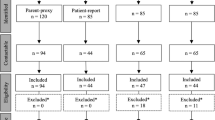Abstract
Objective
To correlate the functional outcomes in children operated for anorectal malformations (ARM) using the Krickenbeck consensus and their quality of life (QOL).
Methods
Thirty-three children operated at a tertiary care Pediatric surgery centre were studied 2 y after completion of all the surgeries and if more than 3 y of age. The functional stooling outcomes, type of anomalies and surgical procedures were tabulated using the Krickenbeck classification. The QOL questionnaire consisted of five parameters (Social habit, school attendance, daily activity, relation to peers and feeling) and the scoring ranged between 0 and 12: Good (8–12), Fair (5–7) and Poor (0–4).
Results
Median age of the children at the time of study was 7 y (Range 4–14). Comparison of stooling outcomes and QOL showed no significant difference (p 0.48). QOL was not affected by the age at evaluation, type of anomaly and type of surgical procedure. Children with vertebral, anorectal, cardiac, tracheoesophageal, radial and limb abnormalities (VACTERL) association had poorer QOL as compared to children without VACTERL association (p 0.02). Poor stooling outcomes were seen in children who underwent abdominoperineal pull through procedure (p 0.02).
Conclusion
QOL appears to be independent of the stooling outcomes in operated children of ARM with majority enjoying a good QOL (93.9%).
Similar content being viewed by others
References
Witvliet MJ, Slaar A, Heij HA, van der Steeg AF. Qualitative analysis of studies concerning quality of life in children and adults with anorectal malformations. J Pediatr Surg. 2013;48:372–9.
Hartman E, Oort F, Aronson D, et al. Critical factors affecting quality of life of adult patients with anorectal malformations or Hirschsprung's disease. Am J Gastroenterol. 2004;99:907–13.
Goyal A, Williams JM, Kenny SE, et al. Functional outcome and quality of life in anorectal malformations. J Pediatr Surg. 2006;41:318–22.
Bai Y, Yuan Z, Wang W, et al. Quality of life for children with fecal incontinence after surgically corrected anorectal malformation. J Pediatr Surg. 2000;35:462–4.
Hashish MS, Dawoud HH, Hirschl RB, et al. Long term functional outcome and quality of life in patients with high imperforate anus. J Pediatr Surg. 2010;45:224–30.
Eiser C, Mohay H, Morse R. The measurement of quality of life in young children. Child Care Health Dev. 2000;26:401–14.
Ludman L, Spitz L. Coping strategies of children with faecal incontinence. J Pediatr Surg. 1996;31:563–7.
Hassink EMA, Rieu PNMA, Brugman ATM, et al. Quality of life after operatively corrected high anorectal malformations. Along term follow up of patients older than 18 years. J Pediatr Surg. 1994;27:773–6.
Hartman E, Oort F, Sprangers M, et al. Factors affecting quality of life of children and adolescents with anorectal malformations or Hirschsprung disease. J Pediatr Gastroenterol Nutr. 2008;47:463–71.
Ditesheim JA, Templeton JM Jr. Short-term vs long-term quality of life in children following repair of high imperforate anus. J Pediatr Surg. 1987;22:581–7.
Aminoff D, LaSala E, Zaccara A. Follow-up of anorectal anomalies: the Italian parents’ and patients’ perspective. J Pediatr Surg. 2006;41:837–41.
Paidas CN. Fecal incontinence in children with anorectal malformations. Semin Pediatr Surg. 1997;6:228–34.
Rintala R, Lindahl H, Louhimo I. Anorectal malformations - results of treatment and long term follow-up of 208 patients. Pediatr Surg Int. 1991;6:36–41.
Holschneider A, Hutson J, Pena A, et al. Preliminary report on the international conference for the development of standards for the treatment of anorectal malformations. J Pediatr Surg. 2005;40:1521–6.
Taylor I, Duthie HL, Zachary RB. Anal continence following surgery for imperforate anus. J Pediatr Surg. 1973;8:497–503.
Author information
Authors and Affiliations
Corresponding author
Ethics declarations
Conflict of Interest
None.
Source of Funding
None.
Rights and permissions
About this article
Cite this article
Raman, V.S., Agarwala, S. & Bhatnagar, V. Correlation between Quality of Life and Functional Outcomes in Operated Children with Anorectal Malformations Using the Krickenbeck Consensus. Indian J Pediatr 84, 177–182 (2017). https://doi.org/10.1007/s12098-016-2269-x
Received:
Accepted:
Published:
Issue Date:
DOI: https://doi.org/10.1007/s12098-016-2269-x




